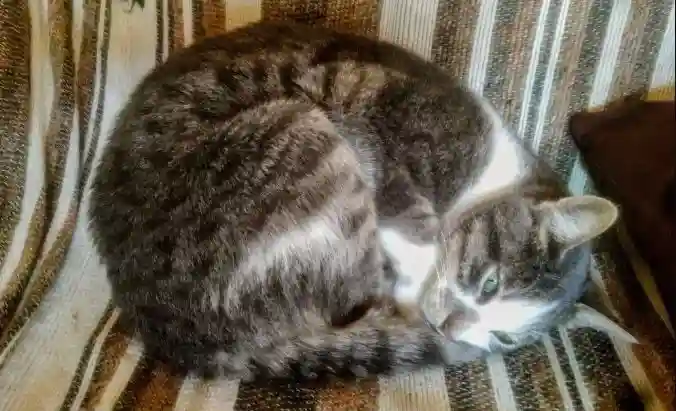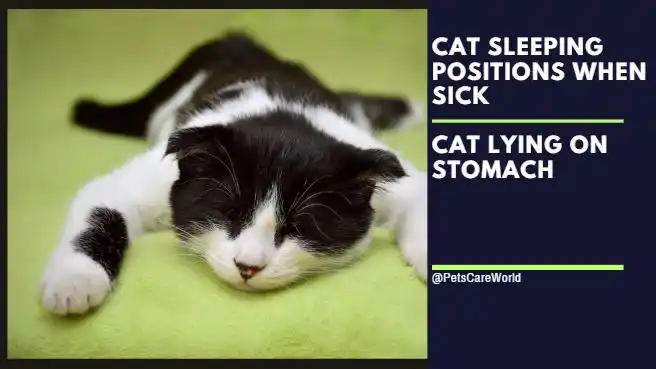Cats are known for their love of sleeping, but sometimes their sleeping positions can reveal more than just their mood. If your cat is sick, you may notice some changes in how and where they sleep. In this article, we will explain some common cat sleeping positions when sick and what they mean. We will also give you some tips on how to help your cat feel more comfortable and recover faster.
Watch Cat Sleeping Positions When Sick Video
Cat Curled Up in a Ball: Cat Sleeping Positions

This is a cozy position that cats often adopt in cold weather to conserve heat. Cats lose a lot of heat through their ears and footpads, so they curl up and tuck them close to their bodies. However, this position can also indicate that your cat has a low body temperature, which can be a sign of hypothermia, shock, infection, or poisoning.
If your cat is sleeping in a ball, check the room temperature and make sure it is around 70 degrees Fahrenheit. You can also provide your cat with a warm blanket or a heated bed to help them stay warm. If your cat’s body temperature drops below 100 degrees Fahrenheit, you should seek veterinary attention immediately.
- Cozy Cat Curl: Cats often tuck themselves into a ball during cold weather to retain body heat.
- Temperature Check: The room temperature should ideally be 70°F for cats in this position.
- Warmth Aids: Provide a warm blanket or heated bed to help your cat stay cozy.
- Warning Signs: The cat’s curled position might indicate a low body temperature or potential health issues.
- Body Temp Alert: Seek vet attention if cat’s body temperature drops below 100°F.
- Health Concerns: Hypothermia, shock, infection, or poisoning could cause a low body temperature.
Cat Sleeping Fetal Position

This is similar to the ball position, but the cat also wraps its tail around its body and covers its face with its paws. This position can mean that your cat is feeling cold, insecure, or in pain. Your cat may be trying to protect a sore or injured body part, such as a wound, an abscess, or a broken bone.
You can try to gently examine your cat for any signs of injury or infection, but be careful not to cause more pain or stress. You can also offer your cat a soft and safe place to sleep, such as a box, a basket, or a cat cave. If your cat shows other symptoms of illness, such as loss of appetite, vomiting, diarrhea, or lethargy, you should take them to the vet as soon as possible.
- Protective Wrap: Cat wraps tail around body, covering face with paws in a defensive, self-soothing position.
- Signals of Discomfort: A cat might feel cold, insecure, or in pain, potentially hiding an injury or soreness.
- Caution in Examination: Gently inspect for injuries or signs of infection without causing added stress or pain.
- Comfort Offerings: Provide a soft, secure sleeping area like a box, basket, or cat cave for your cat.
- Vet Visit: Seek immediate vet attention if the cat displays signs of illness like loss of appetite, vomiting, diarrhea, or lethargy.
- Potential Issues: Injuries such as wounds, abscesses, or broken bones might prompt this protective posture in cats.
- Prioritize Care: Be mindful of your cat’s discomfort and take proactive steps to ensure their well-being.
Cat Lying on Stomach

This is not a common position for cats to sleep in, as it does not allow them to enter deep sleep. Cats usually sleep on their stomachs when they are feeling vulnerable or alert. Your cat may be sleeping on their stomach if they are in a new or unfamiliar environment or if they are feeling stressed or anxious. Your cat may also be sleeping on their stomach if they are too hot, as this position allows them to cool down by having more contact with a cold surface.
You can help your cat feel more relaxed and secure by providing them with a quiet and comfortable place to sleep, away from any sources of noise or disturbance. You can also try to reduce their stress levels by playing with them, grooming them, or giving them some treats. If your cat is overheating, you can move them to a cooler spot, provide them with fresh water, and avoid exposing them to direct sunlight.
- Uncommon Resting Style: Cats rarely sleep on their stomachs due to an inability to enter deep sleep in this position.
- Vulnerability Indicator: Sleeping on the stomach signifies a cat feeling vulnerable or alert, often in new or stressful environments.
- Stress or Heat: Cats might adopt this position due to stress, anxiety, or excessive heat, aiding in cooling down via surface contact.
- Comfort Measures: Offer a quiet, comfortable space away from noise for the cat to relax and feel secure.
- Stress Reduction: Engage in play, grooming, or treat-giving to alleviate the cat’s stress levels.
- Overheating Solutions: If the cat shows signs of overheating, move them to a cooler area, provide fresh water, and avoid direct sunlight exposure.
- Prioritize comfort: Create an environment conducive to relaxation and calmness for your cat’s well-being.
Cat Lying on Back

This is a position that shows trust and confidence, as the cat exposes its belly and throat, which are vulnerable areas. However, this position can also indicate that your cat is feeling insecure or threatened, as it gives them quick access to their claws and teeth for self-defense.
Your cat may be sleeping on their back if they are in a hostile or competitive situation, such as living with other cats or animals, or if they are experiencing some changes in their routine or environment. You can help your cat feel more safe and comfortable by giving them plenty of attention and affection and by avoiding any sudden or loud noises or movements. You can also provide your cat with some toys, scratching posts, or hiding places to keep them entertained and stimulated.

- Trust Display: A cat sleeping on its back exposes its vulnerable belly and throat, signaling trust and confidence.
- Dual Significance: While a sign of trust, it can also indicate insecurity or feeling threatened, allowing quick access to claws and teeth for defense.
- Context Matters: Cats might adopt this position in hostile, competitive environments or during changes in routine or surroundings.
- Comfort Solutions: Provide ample attention and affection. Avoid sudden noises or movements to enhance the cat’s sense of safety.
- Enrichment Options: Offer toys, scratching posts, or hiding spots to keep the cat entertained and mentally stimulated.
- Addressing Insecurity: Especially helpful in multi-pet households or situations where the cat might feel threatened.
- Prioritize Comfort: Create a secure and stimulating environment to support your cat’s well-being and confidence.
Cat Lying on Side

This is a position that shows relaxation and comfort as the cat stretches out its legs and body. However, this position can also indicate that your cat is having difficulty breathing or is suffering from muscular or joint pain. Your cat may be sleeping on their side if they have a respiratory infection, asthma, heart disease, or arthritis.
This position makes breathing easier and reduces pressure on the joints. You can help your cat breathe better by keeping the air quality clean and fresh and by avoiding any allergens, irritants, or smoke. You can also help your cat ease their pain by providing them with a soft and supportive bed and by consulting your vet for any medication or treatment.
Conclusion
Cats sleep in different positions for different reasons, and sometimes their sleeping positions can reveal their health status. If your cat is sleeping in an unusual or uncomfortable position, you should pay attention to their behavior and look for any other signs of illness or pain.
You should also try to make your cat feel more comfortable and cozy by providing them with a suitable temperature, bedding, and environment. If your cat’s condition worsens or does not improve, you should seek professional help from your vet. Remember, your cat’s sleeping position is not a definitive diagnosis, but a clue that can help you understand and care for your cat better.





Leave a Comment
You must be logged in to post a comment.